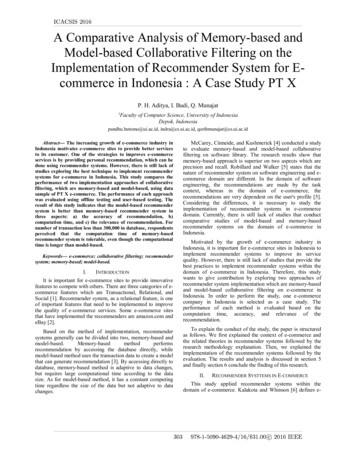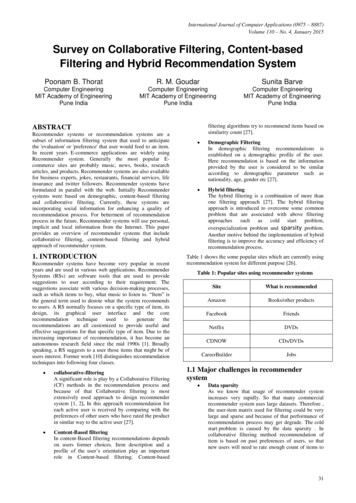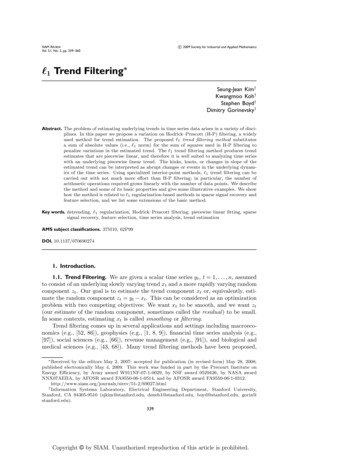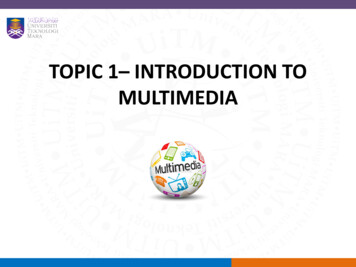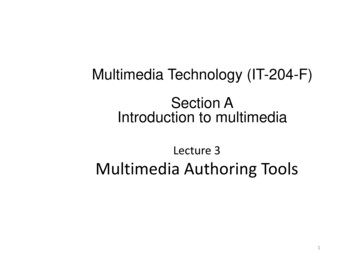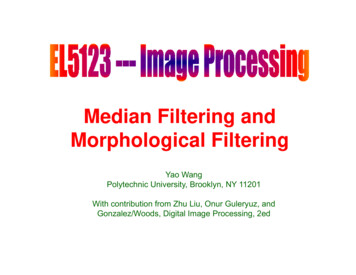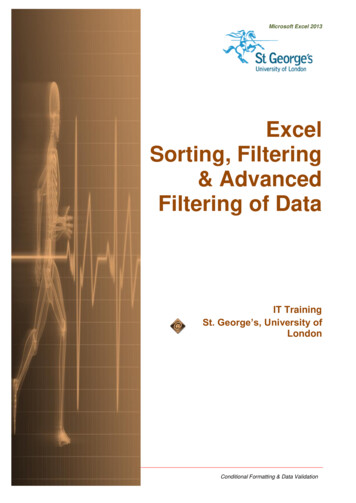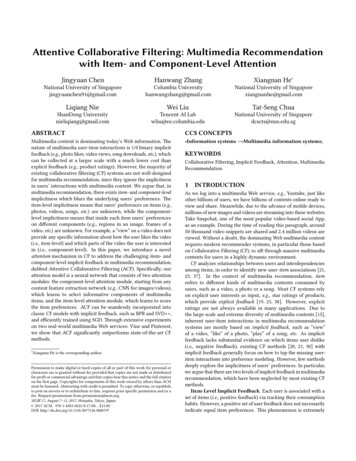
Transcription
Attentive Collaborative Filtering: Multimedia Recommendationwith Item- and Component-Level AttentionJingyuan ChenNational University of Singaporejingyuanchen91@gmail.comLiqiang NieShanDong Universitynieliqiang@gmail.comHanwang ZhangColumbia Universityhanwangzhang@gmail.comWei LiuTencent AI Labwliu@ee.columbia.eduXiangnan He National University of Singaporexiangnanhe@gmail.comTat-Seng ChuaNational University of Singaporedcscts@nus.edu.sgABSTRACTCCS CONCEPTSMultimedia content is dominating today’s Web information. Thenature of multimedia user-item interactions is 1/0 binary implicitfeedback (e.g., photo likes, video views, song downloads, etc.), whichcan be collected at a larger scale with a much lower cost thanexplicit feedback (e.g., product ratings). However, the majority ofexisting collaborative filtering (CF) systems are not well-designedfor multimedia recommendation, since they ignore the implicitnessin users’ interactions with multimedia content. We argue that, inmultimedia recommendation, there exists item- and component-levelimplicitness which blurs the underlying users’ preferences. Theitem-level implicitness means that users’ preferences on items (e.g.,photos, videos, songs, etc.) are unknown, while the componentlevel implicitness means that inside each item users’ preferenceson different components (e.g., regions in an image, frames of avideo, etc.) are unknown. For example, a “view” on a video does notprovide any specific information about how the user likes the video(i.e., item-level) and which parts of the video the user is interestedin (i.e., component-level). In this paper, we introduce a novelattention mechanism in CF to address the challenging item- andcomponent-level implicit feedback in multimedia recommendation,dubbed Attentive Collaborative Filtering (ACF). Specifically, ourattention model is a neural network that consists of two attentionmodules: the component-level attention module, starting from anycontent feature extraction network (e.g., CNN for images/videos),which learns to select informative components of multimediaitems, and the item-level attention module, which learns to scorethe item preferences. ACF can be seamlessly incorporated intoclassic CF models with implicit feedback, such as BPR and SVD ,and efficiently trained using SGD. Through extensive experimentson two real-world multimedia Web services: Vine and Pinterest,we show that ACF significantly outperforms state-of-the-art CFmethods. Information systems Multimedia information systems; XiangnanHe is the corresponding author.Permission to make digital or hard copies of all or part of this work for personal orclassroom use is granted without fee provided that copies are not made or distributedfor profit or commercial advantage and that copies bear this notice and the full citationon the first page. Copyrights for components of this work owned by others than ACMmust be honored. Abstracting with credit is permitted. To copy otherwise, or republish,to post on servers or to redistribute to lists, requires prior specific permission and/or afee. Request permissions from permissions@acm.org.SIGIR’17, August 7–11, 2017, Shinjuku, Tokyo, Japan. 2017 ACM. 978-1-4503-5022-8/17/08. . . 15.00DOI: ollaborative Filtering, Implicit Feedback, Attention, MultimediaRecommendation1INTRODUCTIONAs we log into a multimedia Web service, e.g., Youtube, just likeother billions of users, we have billions of contents online ready toview and share. Meanwhile, due to the advance of mobile devices,millions of new images and videos are streaming into these websites.Take Snapchat, one of the most popular video-based social App,as an example. During the time of reading this paragraph, around50 thousand video snippets are shared and 2.4 million videos areviewed. Without a doubt, the dominating Web multimedia contentrequires modern recommender systems, in particular those basedon Collaborative Filtering (CF), to sift through massive multimediacontents for users in a highly dynamic environment.CF analyzes relationships between users and interdependenciesamong items, in order to identify new user-item associations [21,23, 37]. In the context of multimedia recommendation, itemrefers to different kinds of multimedia contents consumed byusers, such as a video, a photo or a song. Most CF systems relyon explicit user interests as input, e.g., star ratings of products,which provide explicit feedback [19, 25, 38]. However, explicitratings are not always available in many applications. Due tothe large-scale and extreme diversity of multimedia contents [15],inherent user-item interactions in multimedia recommendationsystems are mostly based on implicit feedback, such as “view”of a video, “like” of a photo, “play” of a song, etc. As implicitfeedback lacks substantial evidence on which items user dislike(i.e., negative feedback), existing CF methods [20, 21, 30] withimplicit feedback generally focus on how to tap the missing useritem interactions into preference modeling. However, few methodsdeeply explore the implicitness of users’ preferences. In particular,we argue that there are two levels of implicit feedback in multimediarecommendation, which have been neglected by most existing CFmethods.Item-Level Implicit Feedback. Each user is associated with aset of items (i.e., positive feedback) via tracking their consumptionhabits. However, a positive set of user feedback does not necessarilyindicate equal item preferences. This phenomenon is extremely
prevailing in multimedia services as most of them are socialoriented. For example, some images clicked as “like” may beonly due to the fact that they are taken by friends but are not ofusers’ real interests. Even though for images consistent with users’real interests, users’ preferences on them are not the same. Suchcases that the preference information on each item is not providedare named as item-level implicitness. To better characterize users’preference profile, the implicit feedback in the item-level requiresdifferent attentions on the set of items. However, to the best of ourknowledge, existing CF models generally resort to either a constantweight [23] or pre-defined heuristic weights [21], and thus theconventional neighborhood context obtained by such a weightedsum fails to model the item-level implicit feedback.Component-Level Implicit Feedback. Feedback on multimediacontent is typically at the whole item level. However, multimediacontent usually contains diverse semantics and multiple components.We use component-level implicitness to denote cases that feedbackfor each component is not available. Take a video about a basketballmatch as an example, the whole video contains multiple playersand abundant actions. A “play” feedback from a user on this videodoes not necessarily indicate that the user likes the whole contentof the video, while it may be triggered by his interest in the lastpart of the video which is about the final scores in the match.Therefore, unlike traditional content-based CF methods that onlyconsider multimedia content as a whole [4, 12], we should modeluser preferences with lower-level content components, e.g., imagefeatures in different locations [39] and video features of variousframes [6, 10, 41].However, directly modeling the item-level and component-levelimplicit feedback to facilitate recommendation is non-trivial sincethe ground-truth for the implicitness in each level is not available.To address this problem, we propose a novel CF frameworkdubbed Attentive Collaborative Filtering (ACF) for multimediarecommendation, which can automatically assign weights to thetwo levels of feedback in a distant supervised manner. ACF drawson the latent factor model, by transforming both items and usersto the same latent factor space to make them directly comparable.To incorporate the two levels of implicit feedback, a neighborhoodbased model is integrated to characterize users’ interest profilethrough their historical behavior which is a weighted sum of items.The influence of two levels feedbacks is reflected by the weights ofitems in the neighborhood model. Specifically, in order to modelthe item-level feedback, we propose a weighting function which isa multi-layer neural network and takes the characteristics of bothuser and item, as well as the multimedia content feature as input(cf. Section 4.2). The multimedia content feature in the item-levelis actually generated by assembling multiple components of theitem with attentive weights. In particular, the component-levelattention is also a multi-layer neural network that takes user andcomponent features as input. Then, all the attentive componentstogether compose a content feature vector, which is one of theinput of the item-level attention (cf. Section 4.3). ACF can beefficiently trained using Stochastic Gradient Decent (SGD) on largeuser-item interactions of both images and videos (cf. Section4.4). We evaluate ACF extensively on two real-world datasets thatrepresent a spectrum of different media: Pinterest (images) andVine (videos). Experimental results show that ACF consistentlyoutperforms competing methods ranging from CF-based methods,content-based methods [28, 35] and hybrid methods [9, 33] (cf.Section 5).Our contributions are summarized as follows: We propose a novel CF framework named Attentive CollaborativeFiltering (ACF) to employ attention modeling in CF with implicitfeedback. To the best of our knowledge, this is the firstframework that is designed to tackle the implicit feedback inmultimedia recommendation. To address two levels of implicit feedback, we introduce twoattention modules, each is a neural network that can beseamlessly incorporated into any neighborhood models withefficient end-to-end SGD training. Through extensive experiments conducted on two real-worlddatasets, we show that ACF consistently outperforms severalstate-of-the-art CF methods with implicit feedback.2 RELATED WORK2.1 Implicit FeedbackRecommendation with implicit feedback is also called the one-classproblem [27] because of the lack of negative feedback, where onlypositive feedback (e.g., click, view) is available. Apart from thepositive feedback, the remaining data is a mixture of real negativefeedback and missing values. Therefore, it is hard to reliably inferwhich item a user did not like from implicit feedback.To cope with the problem of missing negative samples, severalapproaches have been proposed which can be roughly classifiedinto two categories: sample based learning [20, 27, 30] and wholedata based learning [21, 23]. The former samples negative feedbackfrom the missing data, while the latter treats all the missing data asnegative. Therefore, sample-based approaches are more effectivewhile whole-data based approaches provide higher coverage.Traditional whole-data based methods assume that all unobservedevents are negative samples and are equally weighted [23].However, this may not be realistic, due to the fact that theunobserved data may contain missing values which are falsenegative. Towards this end, several recent efforts [21, 27] focuson the weighting scheme, taking the confidence whether theunobserved samples are indeed negative ones into consideration.For example, certain nonuniform weighting schemes on thenegative samples, such as user-oriented [27] and item popularityoriented [21], have been proposed and proven to be more effectivethan the uniform weighting scheme. However, one major limitationof the non-uniform weighting method is that the weighting schemesare defined based on assumptions proposed by the authors, whichmay not be correct in the real data.As can be seen, most of the existing efforts till now focused onthe negative feedback sampling or weighting schemes to tacklethe problem of no negative feedback, while no much attentionhas been paid on the two levels of implicit feedback—item-levelattention and component-level attention—which can be seen asthe weighting strategy on positive samples. To fill up the empty inpositive sample weighting, we propose a novel attention mechanismto weight positive implicit signal automatically based on the useritem interaction matrix and the content of the item.
2.2Multimedia RecommendationThe significance of multimedia recommendation has led to thegreat attention from both the industry and academia [8, 16, 32, 36].Most of the current state-of-the-art multimedia recommendationtechniques are based on the CF analysis [2, 4]. Although theseapproaches work well for popular and frequently watched contents,they are less applicable to fresh contents or tail contents withfew views, due to the sparsity of the data. Therefore, for theseitems, CF analysis based solely on user-item interaction matrixor co-views information may yield either low-quality suggestionsor no suggestions at all. To address the problem of tail contents,researchers have developed hybrid approaches [33] that incorporatethe context and content of multimedia items with the CF modelfor recommendation. For example, several efforts have beendedicated to conduct the video recommendation utilizing differentcontext information, such as the multi-modal relevance [26, 34],cross-domain knowledge [11, 14] and latent attributes feature [12,44]. Moreover, [3, 4] have proposed hybrid approaches to videorecommendation, which combines the video content (topics minedfrom video metadata, related queries, etc.) with the co-viewinformation. Another widely used strategy is using a latent factormodel for recommendation, and further predicting the latent factorsfrom multimedia contents to handle the cold start scenario [15, 33].However, most of the exisitng methods failed to pay attention tothe two levels of implicitness in the multimedia recommendation,which is the major concern of our work.2.3Attention MechanismAttention mechanism has been shown effective in various machinelearning tasks such as image/video captioning [7, 39, 40] andmachine translation [1]. Its success is mainly due to the reasonableassumption that human recognition does not tend to process awhole signal in its entirety at once; instead, one only focuses onselective parts of the whole perception space when and whereas needed. Our component-level attention adopts the soft spatialattention model in [39] for images and the soft temporal attentionmodel in [40] for videos. The key idea of soft attention is to learnto assign attentive weights (normalized by sum to 1) for a set offeatures: higher (lower) weights indicate that the correspondingfeatures are informative (less informative) for the end task.In fact, the attention assumption is reasonable in many realworld situations, not just in the domain of computer vision andnatural language processing. To the best of our knowledge, ACFis the first attention-based CF model in the area of recommendersystems.3PRELIMINARIESWe begin with some notations. We denote a user-item interactionmatrix as R RM N , where M and N denote the number of usersand items, respectively. Specifically, we use Ri j to represent the(i, j)-th entry of R. As for implicit feedback, Ri j 1 indicates thatthe i-th user has interacted with the j-th item and Ri j 0 indicatesthat there is no interaction between user i and item j in the observeddata. We use R {(i, j) Ri j 1} to denote the set of user-itempairs where there exist implicit interactions. The goal of a CF modelwith implicit feedback is to exploit the entire R to estimate R̂i j forthe unobserved interactions.3.1Latent Factor ModelsLatent factor models map both users and items to a joint lowdimensional latent space where the user-item preference score isestimated by vector inner product. We will focus on models that areinduced by Singular Value Decomposition (SVD) on the user-itemratings matrix. We denote user latent vectors as U [u1 , ., uM ] RD M and item latent vectors as V [v1 , ., vN ] RD N , whereD min(M, N ) is the latent feature dimension. The preferencescore Ri j is estimated as:R̂i j ui , vj uTi vj .(1)The objective is to minimize the following regularized squared losson observed ratings:Õarg min(Ri j R̂i j )2 λ( U 2 V 2 ),(2)U,V(i, j) Rwhere λ controls the strength of regularization, which is usually anL 2 norm to prevent overfitting. After we obtain the optimized userand item vectors, recommendation is then reduced to a rankingproblem according to the estimated scores R̂i j .However, applying SVD in implicit feedback domain raisesdifficulties due to the high portion of unobservable data. Carelesslytreating the unobserved entries as negative samples in SVD mayintroduce false negative samples in the training data.3.2Bayesian Personalized Ranking (BPR)BPR is a well-known framework for addressing the implicitness inCF [30]. Instead of point-wise learning as in SVD, BPR models atriplet of one user and two items, where one of the items is observedand the other one is not. Specifically, from the user-item matrix R,if an item j has been viewed by user i, then it is assumed that theuser prefers this item over all the other unobserved items.The optimization objective for BPR is based on the maximumposterior estimator. In particular, by applying the above latentfactor models, a widely used BPR model is given as:Õarg min ln σ (R̂i j R̂ik ) λ( U 2 V 2 ), (3)U,V(i, j,k) R Bwhere σ is the logistic sigmoid function and λ is regularizationparameter. The training data R B is generated as:R B {(i, j, k) j R(i) k I\R(i)},(4)where I denotes the set of all items in the dataset and R(i)represents the set of items that are interacted by the i-th user. Thesemantics of (i, j, k) R B is that user i is assumed to prefer item jover k.In this work, we use BPR as our basic learning model because ofits effectiveness in exploiting the unobserved user-item feedback.4ATTENTIVE COLLABORATIVE FILTERINGIn this section, we will introduce our Attentive CollaborativeFiltering (ACF) model in detail. First, we present the general ACFframework, elaborating the motivation of the model. We thenshow the detailed formulations of the proposed item-level and
component-level attentions. Note that in the following sections,“item-” means video or image, and “component-” means the framein video or space region in images. Lastly we will go through theoptimization details of ACF.4.1General FrameworkACF is a hierarchical neural network that models user’s preferencescore with respect to the item in item-level and content incomponent-level. Given a user i, an item l and the m-th componentin item l, we use α(i, l) to denote user i’s preference degree in iteml and further β(i, l, m) to denote user i’s preference degree in them-th component of item l. We use two attention sub-networks tolearn these two preference scores jointly. Specifically, we employcomponent-level module to generate content representations foreach item and item-level module to obtain user representation.Objective Function. In addition to explicitly parameterizingeach user i with ui , ACF also models users based on the set of itemsR(i) that they interacted with. Therefore, each item l is associatedwith two factor vectors. One is denoted by vl , which is the basicitem vector in latent factor model. The other one, denoted by pl , isthe auxiliary item vector which is used to characterize users basedon the set of items they interacted with. The representation of aÍuser i is through the sum: ui l R(i) α(i, l)pl .ACF is optimized in the BPR pairwise learning objective [30]:optimizing the pairwise ranking between the positive and nonobservable items:T Õ ªarg min ln σ ui α(i, l)pl vj U,V,P,Θ (i, j,k) R Bl R(i) «T Õ ªα(i, l)pl vk λ( U 2 V 2 P 2 ), ui l R(i)« Õ(5)where set R(i) denotes the set of items that are interacted by thei-th user and Θ is the parameters in attention network. α(i, l) is theitem-level attention module, which measures the preference degreeof user i to item l. Note that the component-level attention moduleis also integrated into α(i, l).Inference. After we obtain the optimized user, item andauxiliary item vectors, i.e., U, V and P, as well as the parametersof the attention networks, recommendation is then reduced toa ranking problem among all the items in the dataset based onestimated score R̂i j :TÕ ªR̂i j ui α(i, l)pl vj .l R(i)« (6)Relations to Neighborhood Models. Note that if we rewriteEqn. (6) as:l at ent f act or modelR̂i j z} {uTi vj Õl R(i) α(i, l)pTl vj ,{z}neiдhbor hood model(7)Figure 1: The architecture of our proposed AttentiveCollaborative Filtering framework. Our attention modelcontains two level modules: component-level attention anditem-level attention (cf. Section 4.1).where pTl vj can be viewed as the similarity measure functionbetween items in the neighborhood-based collaborative filtering [24].The first part of Eqn. (7) corresponds to the latent factor modeland the second part corresponds to the neighborhood model.Specifically, if we replace the attention weight α(i, l) with a1 , our ACF model will degenerate intonormalized weight R(i) SVD [25]; or, the weight is a heuristic function, ACF is similar toFISM [24]. However, they failed to consider the two levels of implicitfeedback in recommendation, where a fixed weight assumes that allthe items contribute equally to the prediction. In fact, the weightsshould be highly dependent to the user and the item content as wewill introduce in Section 4.2 and Section 4.3.Figure 1 illustrates the workflow of ACF. We start from the set ofitems that are liked by the i-th user. First, for each item l, we accessthe set of component features {xlm } (blue solid circles), where xlmcould be the image region feature at the m-th spatial location [39]or the frame feature of the m-th frame in a video [41]. Then, thecomponent-level attention module, which is a sub-network, takesthe user latent vector ui and the feature xlm as input and output thecomponent-level attentive weight β(l, m) for the m-th component(dashed blue circles). Thus, the final representation of the l-thÍitem content xl is calculated by the weighted sum β(l, m)xlm(filled blue circles). After we have obtained xl , we can use theitem-level attention module by taking user latent vector ui , itemlatent vector vl , auxiliary item latent vector pl , and the contentfeature xl to calculate the item-level attentive weight α(i, l) foreach neighborhood item (dashed green squares). Then, similar tothe component-level attentions, we obtain the final neighborhoodÍvectors for user i by the weighted sum α(i, l)pl (filled green
Algorithm 1: Attentive Collaborative FilteringInput: User-item interaction matrix R. Each item l isrepresented by a set of component features {xl }.Output: Latent feature matrix U, V, P and parameters inattention model Θ1: Initialize U, V and P with Gaussian distribution. Initialize Θwith xavier [17].2: repeat3:draw (i, j, k) from R B4:For each item l in R(i):5:For each component m in {xl }:6:Compute β(i, l, m) according to Eqns. (10) and (11)7:Compute xl according to Eqn. (12)8:Compute α(i, l) according to Eqns. (8) and (9)Í9:ui0 ui l R(i) α(i, l)pl10:R̂i jk ui0 vj ui0 vk11:For each parameter θ in {U, V, P, Θ}:12:13:14:Update θ θ η · (until convergencereturn U, V, P and Θ. R̂ i jkexp R̂ i jk1 exp R̂· θi jk λ · θ ).Item-Level AttentionThe goal of the item-level attention is to select items thatare representative to users’ preferences and then aggregate therepresentation of informative items to characterize users. Giventhe basic user latent representation ui , the neighborhood item latentvector vl , the neighborhood auxiliary item vector pl , and the itemcontent feature xl (detailed in the next section), we use a two-layernetwork to compute the attention score a(i, l) as,a(i, l) wT1 ϕ(W1u ui W1v vl W1p pl W1x xl b1 ) c1 . (8)where the matrices W1 and bias b1 are the first layer parameters,and the vector w1 and bias c1 are the second layer parameters;ϕ(x) max(0, x) is the ReLU function, which was found better thana single layer perceptron with a hyperbolic tangent nonlinearity.The final item-level weights are obtained by normalizing theabove attentive scores using Softmax, which can be interpreted asthe contribution of the item l to the preference profile of user i:α(i, l) Íexp (a(i, l))n R(i) exp (a(i, n))4.3b(i, l, m) wT2 ϕ(W2u ui W2x xlm b2 ) c2 ,.(9)Component-Level AttentionMultimedia items contain complex information while differentusers may like different parts of contents in the same multimediaitem. Each multimedia item l may be encoded into a variable-sizedset of component features {xl }. We use {xl } to denote the size ofthe set and xlm to denote the feature of the m-th component in theset. Unlike conventional content-based CF models that generallyadopt average pooling [6, 33] for extracting a unified representation,the goal of component-level attention is to assign components(10)where the matrices W2 and bias b2 are the first layer parameters,and the vector w2 and bias c2 are the second layer parameters;ϕ(x) max(0, x) is the ReLU function. Then, the final componentlevel attention is normalized as:exp (b(i, l, m)).β(i, l, m) Í {xl } exp (b(i, l, n))n 1(11)After we obtain the component-level attention β(i, l, m), thecontent representation of item l with the encoded preference ofuser i is calculated as the following weighted sum:xl squares). Lastly, combined with the basic user latent vector, wecan use stochastic gradient descent to optimize the BPR pairwiselearning objective (cf Eqn. (5)).4.2attentive weights that are consistent with user preference, and thenapply the weighted sum to construct the content representation.Similar to the item-level attention, the component-level attentionscore for the m-th component xlm of item l from user i is also atwo-layer network:4.4 {xl } Õm 1β(i, l, m) · xlm ,(12)AlgorithmA stochastic gradient descent algorithm based on bootstrapsampling of training triples is proposed to solve the network. Thesteps for training the model are summarized in Algorithm 1.For notational simplicity, we divide ACF into three steps: 1)subroutine ACFcomp runs from Line 5 to Line 7. Note that thecomponent can be image region features for image or video framefeature for video; 2) subroutine ACFitem runs from Line 4 to Line9; and 3) subroutine BPR-OPT runs back propagation with respectto Eqn. (5). Due to space limit, we use Θ to denote the set ofparameters in item-level attention and component-level attention,and R̂i jk to denote R̂i j R̂ik . Note that Line 12 are the gradients ofthe model parameters updated using chain rules. To optimize theobjective function, we employ stochastic gradient descent (SGD)— a universal solver for optimizing neural network models. Ateach time, it randomly selects a training instance and updates eachmodel parameter towards the direction of its negative gradient.Note that if more computational resources are available, wecan also achieve end-to-end CNN module fine-tuning. We willinvestigate whether we can train more powerful visual featuresusing user-item implicit feedback in future.5EXPERIMENTSIn this section, we will conduct experiments to answer the followingresearch questions: RQ1 Does ACF outperform state-of-the-art recommendationmethods? RQ2 How do the proposed item-level and component-levelattentions perform?We will first present the experimental settings, follow byanswering the above two research questions, and end with someillustrative examples.
5.1Experimental SettingsDatasets. We experimented with two publicly accessible datasets:Pinterest1 and Vine [5]. The characteristics of the two datasets aresummarized in Table 1.Table 1: Statistics of the evaluation 9.85%99.96%1. Pinterest. This implicit feedback dataset is constructedby [15] for evaluating image recommendation. Due to the largevolume and high sparsity of this dataset, for instance, over 20%of users have only one pin, we filter the dataset by retainingthe top 15, 000 popular images and sampling 50, 000 users whohave interactions on the 15, 000 images. This results in a subsetof data that contains 50, 000 users, 14, 965 images and 1, 091, 733interactions. Each interaction denotes whether the user has pinnedthe image to his/her own board.2. Vine. This video dataset [6, 45] is crawled from Vine, a microvideo sharing social network. The crawling starts with a set ofactive users. Then the breadth-first crawling strategy is adoptedto expand the seed users by crawling their followers. Totally, thedataset contains 98, 166 users and their interactions on 1, 303, 242micro-videos. An interaction denotes whether the user has postedor re-posted the video. To evaluate the recommendation task, wefiltered the dataset by retaining users with at least 4 interactions.This results in a subset of data that contains 18, 017 users, 16, 243videos and 125, 089 interactions.Evaluation Protocols. To evaluate the performance of itemrecommendation, we adopted the leave-one-out evaluation, whichhas been widely used in literature [21, 30]. For each user, weheld-out his/her latest interaction as the test set and utilized theremaining data for training. As we mentioned in Section 3.1, therecommendation task is reduced to a ranking problem based on theestimated score. To assess the ranked list with the ground-truthitem that user has actually consumed, we adopt Hit Ratio (HR) andNormalized Discounted Cumulative Gain (NDCG) [13], where HRmeasures whether the ground truth item is present on the rankedlist and NDCG accounts for the position of hit [19]. We reportthe average score for all test users. If not specifically specified, wetruncate the ranked list at 100 among all the items for both metrics.Baselines. We compared ACF with the following methods. Notethat all
Filtering (ACF) to employ a ention modeling in CF with implicit feedback. To the best of our knowledge, this is the rst framework that is designed to tackle the implicit feedback in multimedia recommendation. To address two levels of implicit feedback, we introduce two a ention modules, each is a neural network that can be
